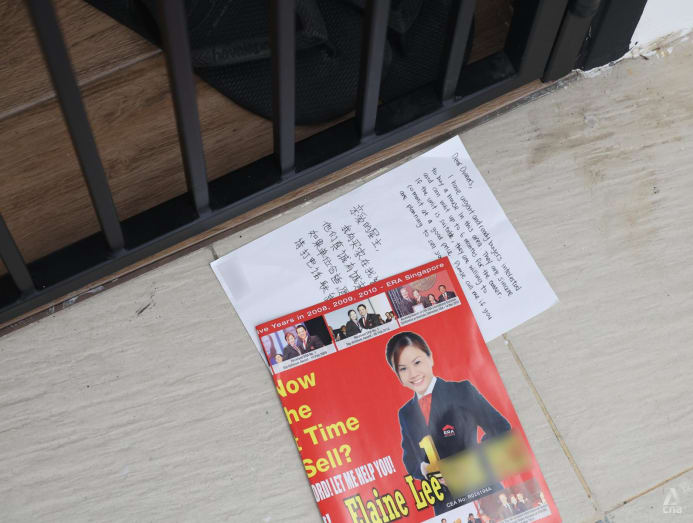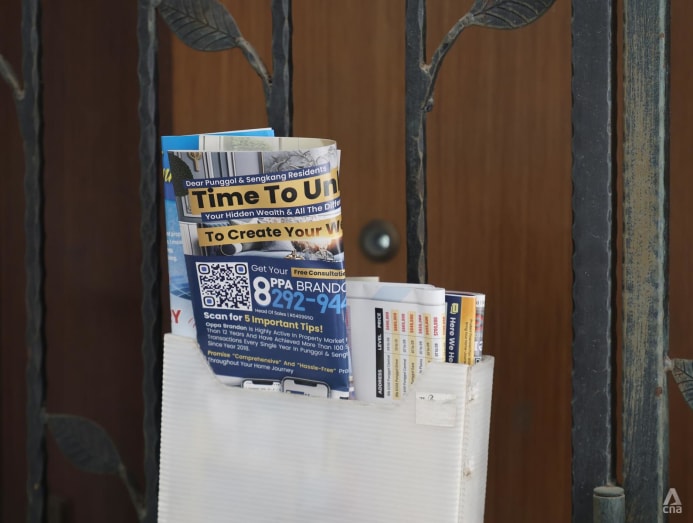Property flyers a 'numbers game' that tests residents’ patience against agents’ pockets
Property agents continue to rely on printed flyers as a low-cost, high-visibility way to reach potential clients, despite frustration from home owners over what they regard as spam.

A flyer advertising a property was left at the doorstep of a public housing unit in Woodlands on May 8, 2025. (Photo: CNA/Ooi Boon Keong)

This audio is generated by an AI tool.
Fed up with leaflets from property companies and agents, Pasir Ris resident Amara Ong once confronted a distributor while he was slipping one through the main door of her home, telling him to "take it back".
She admitted that she might have startled the person who was just doing his job, but she said that her aversion to these leaflets began after moving into her resale flat in 2020.
Her disdain for them grew as the volume surged after COVID-19 restrictions were lifted.
Sometimes, she would open the door and find as many as three or four flyers wedged awkwardly into the gate, or worse, strewn all over the corridor floor of the public housing block.
“It’s like an invasion of privacy. It feels like someone’s throwing rubbish into my home. I don't mind if they put it in my mailbox,” the 36-year-old accountant said.
Another time, Ms Ong lodged a formal complaint with the Advertising Standards Authority of Singapore, only to be told that it could not act on her feedback because it does not regulate distribution methods.
She now makes it a point to avoid engaging property agents who send her flyers. “I'm more inclined to go directly through online portals or referrals, or maybe even cleverly done social media posts or videos. Flyers are just a waste of paper," she said.
Ms Ong is not alone in her dislike of real estate spam. Every now and then, complaints about these materials surface in popular online forums, featuring photos of walkways littered with flyers and residents sharing tips on how to ward off unwanted marketing.
Some online users suggested placing a dustbin in front of their door specifically for discarded flyers. Others would send the listed contact numbers of property agents to insurance agents for a taste of their own medicine, or even personally confront the property agent over the phone to tell them off for littering.
If these marketing practices are so reviled by some home owners, why are property agents still relying on flyers to reel in potential sellers or buyers?
To this, property agents interviewed by CNA TODAY said that flyer distribution remains one of the more consistent, tangible ways to build presence and increase awareness, especially in public housing estates.
Although this practice is not always welcomed, it is part of what some agents describe as a numbers game: the more units they reach, the higher the chance of a response, especially from people who are not digitally savvy.
Nevertheless, this strategy is a double-edged sword. Some agents said they have managed to generate leads, while others feel that the returns on investment (ROI) are low given the cost of such marketing campaigns.
Rather than driving direct conversions, they see it more as a tool for personal branding and maintaining visibility in the neighbourhood.
This approach has become more widespread with a growing pool of real estate agents in Singapore. Official data showed that the number of agents rose from 30,073 in 2020 to 35,251 last year, reflecting increased interest in the profession.
Industry players attributed this rise to the sector’s growing credibility, backed by tighter regulations, more rigorous entry examinations and a broader skill set that goes beyond salesmanship, helping to shed its old “cowboy” image and attracting more graduates as a serious career path.
Their flyers often feature their faces and contact details prominently, along with claims such as "award-winning agent" and "trusted realtor", as well as recent transaction records in the area – all designed to build credibility and subtly encourage passive home owners to consider selling their apartments.
In the end, a single successful transaction resulting from a property flyer campaign can make the agent's investment worthwhile in the long run.

A FORM OF TANGIBLE, LONG-TERM BRANDING
Property agents who spoke to CNA TODAY said flyer distribution is a way to maintain visibility in competitive housing estates where many agents often vie for the same pool of clients, but it is not without cost or uncertainty.
While printing and distribution may seem straightforward, the returns can be unpredictable.
For property agent Nikmat Jawini, 35, who once distributed up to 20,000 flyers a month in Pasir Ris, the returns can be too inconsistent to justify the cost.
“One round of 10,000 flyers costs me about S$555. That barely covers half of Pasir Ris. And you need at least two rounds a month for people to even begin recognising your face,” he disclosed.
“If you only do it once, you’re just throwing money away because they’ll toss the flyer without a second look.”
Likewise, ERA Realty Network's division director Richmond Chia, 53, sees flyer distribution as a low-return strategy, unless agents are prepared to invest in it consistently over time.
“You need to repeatedly send flyers to the same targeted area for at least six months. The question is, how long can you sustain the cost?” Mr Chia asked. He has been in the industry for nearly two decades.
“It’s about timing and luck. You need to catch sellers when they’re ready. Whether it’s a new or mature estate, there is always some activity. But without the funds to (distribute) consistently for six to 12 months, your chances are slim.”
PropNex Realty's associate group director Nicholas Cho, 47, said flyers are still a key part of a broader, multi-platform strategy for him and his team.
Being active on video-sharing platform TikTok as well, he allocates around S$2,000 a month to flyer printing and distribution, covering different estates depending on market cycles.
“It’s about balance. Roughly 20 per cent of my leads still come from flyers. The rest is a mix, including social media, door knocking, referrals and telemarketing,” he added.
“You can’t rely on just one form of outreach.”
On his other forms of outreach, Mr Cho said he spends a combined average of S$5,000 every month.
Even though most home owners might toss the flyers into the trash can as soon as they get them, Mr Cho believes that the flyers serve a purpose because the digital landscape is competitive, coupled with people’s attention spans becoming shorter.
“Traditional methods still play a role, especially for the older generation, who prefer physical copies. They can read them and pass them around.
“So I think we can't neglect that. In some cases, we also use newspapers to list the units we're selling. We do see results because people do still use traditional media for their reading.”
Another property agent, Mr Brandon Choi, 52, said that agents who choose to market themselves using flyers should be prepared to invest in the method for the long term, because he has seen many give up after just a few months.
“It’s not that flyers have a low ROI. I’ve been doing this long enough to know they still work if you give them time. The problem is, many agents try it for a few months and then give up. This is a long game.”
To Mr Choi, who is head of sales at Singapore Estate Agency and has been distributing flyers in the Punggol and Sengkang area for about six years, social media is useful primarily for branding, not necessarily for converting leads.
“Even if you spend S$2,000 to S$3,000 a month on online advertising, there is a very high chance you don’t get a response. It’s very saturated because everyone posts the same testimonial-style videos or house tours, and people just scroll past.”
Flyers, on the other hand, offer a tangible, persistent reminder, Mr Choi added.
“If someone really wants to sell, they might happen to see your flyer or remember your face. That’s how it works – not immediately, but eventually.
“But for me, flyers still perform better than other platforms. I’m not the kind of agent who’s good at making videos. Not everyone is comfortable dancing on TikTok.”
Apart from the basic flyer, some agents have expanded their range of marketing collaterals to include fridge magnets, which often come with functional designs such as calendars or memo pads for writing. A few agents go as far as to distribute handheld fans to stave off heat.
Property agent Nur Fajrina Abdul Rashid, 35, is one of them. She said that as a consumer, she dislikes receiving flyers, so she has focused her marketing efforts on distributing handheld fans and magnets instead.
She orders about 1,000 fans for S$500 when doing road shows each time.
“For me, it’s about exposure. I don’t expect people to call me directly because of the fan or magnets, but if they ever need an agent, they might reach out (to me),” she added.
“It’s really a matter of luck and it’s the most cost-effective form of marketing.”

RESPECTING PREFERENCES AND FEEDBACK
Mr Raymond Khoo, the head of agency at property firm OrangeTee & Tie, said that although digital platforms offer more measurable returns on investment, flyers still play a role in hyperlocal outreach, particularly for agents focused on specific neighbourhoods or public housing precincts.
Ultimately, flyers are complementary to digital marketing, not a replacement, and the ideal strategy integrates both for maximum visibility and engagement, he added.
Mr Khoo also said that the company is mindful of home owners' preferences because it has received feedback regarding flyer distribution and this is taken seriously.
"(We) proactively remind our agents to follow best practices such as targeting relevant areas, respecting no-flyer zones and adhering to all CEA guidelines, to ensure responsible and respectful outreach," he said, referring to the advertising guidelines for estate agents and salespersons by the Council for Estate Agencies (CEA).
"We also regularly remind agents that marketing efforts should enhance our reputation, not jeopardise it.
"We also have an internal ‘no distribution list’, which contains addresses of home owners who opted out of our marketing." Agents are therefore reminded to check the list before proceeding with distribution.
Mr Khoo stressed that the company actively encourages marketing practices that are ethical, compliant with CEA's guidelines and uphold a professional image for both the agent and the agency.
"This includes the use of factual, well-substantiated claims, clear calls to action and respectful engagement with home owners.
"We discourage overly aggressive or misleading tactics, as well as any form of canvassing that may intrude on personal space or cause public nuisance.
"We’ve also discouraged the use of terms like 'guaranteed sale' or 'sure sell,' as such claims may be construed as misleading if not supported by verifiable data."
Similarly, at PropNex Realty, its chief agency officer Eddie Lim said that all feedback, whether from the public or regulators, is taken seriously and that salespersons are consistently reminded to avoid flyer distribution in restricted areas and to respect the Do Not Call (DNC) registry.
"Our salespersons are guided by a comprehensive set of marketing guidelines and a clear social media policy to ensure their marketing efforts are professional, ethical and aligned with regulatory standards."
The DNC registry, introduced in 2014, allows people to opt out of telemarketing messages or messages of a commercial nature addressed to their Singapore telephone number. Anyone wishing to do so may register online, by SMS or by phone.
The registry does not restrict physical advertisements to home addresses.
FLYERS SHOULD NOT MISLEAD
When it comes to the contents of flyers, different agents have different ideas of what works best.
After reviewing around 50 property flyers, CNA TODAY found several common elements:
- Recent high-value transactions in the area
- A breakdown of the agent’s services
- The types of properties they have sold
- Clients' testimonials
In Mr Cho’s experience, his team experiments with content, sometimes including comparative market data, sometimes focusing on financial education such as accrued interest in the Central Provident Fund (CPF), a topic many home owners overlook. Singaporean home owners usually use savings from their CPF accounts to pay for their housing needs.
“Our goal is to add value, not just push for sales,” Mr Cho said.

For Mr Nikmat, he finds that people are generally receptive to complimentary services such as free valuation and free consultation. In his flyers, he made sure to highlight these clearly to attract prospective clients.
Some go a step further by using positive descriptors such as “award-winning” or “top-selling”.
And with some flyers using persuasive phrases such as “high prices guaranteed” or “we have urgent and ready buyers looking for flats in your area”, the credibility of such marketing has also come under scrutiny.
This has also made some agents wary of questionable ethics in flyer marketing. “Agents must be honest. You can’t start by deceiving people,” Mr Choi said.
Mr Nikmat, too, called out the use of seemingly exaggerated claims on flyers. For instance, that there are ready buyers or overpromising “unrealistic prices”, which he described as untruthful.
“For example, they might promise S$1.4 million, but the actual value turns out to be closer to S$800,000,” he said.
“If you’re sensible as a client, you’ll think it’s too good to be true. But if you’re not, you might believe it’s real.”
Although not as common, another type of flyer is sent via registered mail and addressed to the “owner of the unit”. These letters often resemble official corporate letters, but inside, they contain a promotional message or sales pitch from a property agent.
Then there is the problem of clutter.
In competitive housing estates, multiple agents targeting the same area can lead to all their flyers being bundled and placed at a home owner's door, undermining the visibility they seek. This is the case with Ms Ong, who sometimes receives several flyers at her doorstep in a week.
This can also lead to complaints, since residents believe that such practices violate guidelines for responsible distribution.
WHAT ESTATE AGENTS CAN OR CANNOT SAY IN ADVERTISEMENTS
Under the practice guidelines on ethical advertising by the Council for Estate Agencies, which must be adhered to by anyone advertising a property, some of the requirements are:
- The information must be accurate. If the advertisement shows a photograph of a property, the photograph must not be altered or enhanced in any way
- The information must not be misleading. Any claims of gains and returns must be substantiated
- No claims such as "guarantee sell high price above value", "all units sold high price above valuation" or explicitly, any guarantee of cash over valuation (getting money due to a higher selling price over the market value)
- Flyers and pamphlets to homes and other premises must be properly distributed without being visible to members of the public other than the intended recipient, to avoid a build-up of distributed materials within public view when owners are away
- If estate agents or salespersons entrust a third party to distribute flyers or put up banners, they must issue proper instructions to the third party to ensure that the advertisement and its distribution comply with the law and guidelines
- To obtain the requisite approvals before putting up signs or banners in common areas of public housing estates such as bus stops or along roads
- Advertising content must not give a false representation that the estate agent or salesperson has ready properties available for potential clients
Agents typically are not the ones who distribute the flyers themselves. Instead, they rely on third-party services to handle the delivery.
When it comes to engaging distributors, some agents also face challenges in ensuring that their materials are fully delivered.
Mr Nikmat and Mr Chia, for example, have heard of dishonest practices by third-party vendors.
“They’ll take a photo of flyers at just a few houses to show that the job is done, then dump the rest. Finding a reliable distributor who puts out all 10,000 flyers is quite hard,” Mr Nikmat said.
Mr Chia said that distribution, not the printing of flyers, is the most expensive component of flyer campaigns. Distribution can cost an extra S$800 to S$900.
“I don’t use companies that handle both printing and delivery because I’m sceptical about whether they follow through with the service. You often hear stories of them delivering just 20 to 40 per cent of the batch.”
As for what happens with the rest of the flyers, it is anyone's guess.
In response to CNA TODAY's queries, CEA said it may take the appropriate enforcement action against any property agent who breaches its code of ethics and professional client care or the practice guidelines on ethical advertising.
The council added that possible enforcement actions include issuing a warning or censure, imposing a financial penalty of up to S$5,000 or referring the case to a disciplinary committee, which may result in disciplinary action such as financial penalties and suspending the agent’s registration.

FLYERS WON'T GO AWAY ANYTIME SOON
Despite the general disdain from home owners towards flyer marketing, marketing experts told CNA TODAY that the practice is likely to continue in the long term, because it remains a practical and targeted marketing tool not just for property agents, but for anyone looking to advertise their services.
The main reason is that they are relatively low-cost and can be distributed widely to maximise effectiveness.
Professor Lawrence Loh, director of the Centre for Governance and Sustainability (CGS) at NUS Business School, said that flyers offer broad reach but they can also be customised to target specific estates.
“For example, some brochures include the estimated value of your property based on recent transactions, so it’s not just generic marketing. It can be quite specific,” he added.
“They continue to use flyers because it’s a low-cost method. And in many ways, it’s like playing the lottery. You send out a bunch and if one hits, it’s like striking the jackpot.”
Dr Seshan Ramaswami, associate professor of marketing education at Singapore Management University, said physical flyers work best when promoting services mainly relevant to people living nearby such as a tutor or a car wash service in the neighbourhood.
He acknowledged that flyer distribution leads to “tremendous wastage”, since only a small fraction of recipients would likely be genuinely interested.
“But if the costs of designing, printing and distributing are low, it might still be worthwhile, because even a very small rate of conversion may result in a large profit."
Given the prevalence of digital marketing, Dr Ramaswami noted that there is indeed fatigue in advertisement exposure on all media and it is best to focus efforts on finding customers digitally. This may mean regularly uploading and bumping up posts on mobile applications and online marketplaces.
"But these ads work best for those who are already in the market to buy or to sell."
He added that a flyer placed in someone’s mailbox with a message of "ready buyer for your flat" could spark consideration from a home owner who had not previously thought of selling – a "serendipitous" effect that digital ads are less likely to achieve.
As for the tension between home owners frustrated by the frequency of such mail drop and agents trying to earn a living, Prof Loh pointed out that a blanket ban on flyer distribution is not feasible, since other parties advertise a variety of services through similar means.
He proposed an opt-out mechanism as a potential solution, where residents who do not want to receive flyers could display a designated sticker indicating their preference.
“We could even have a bureau or registry to manage this, then it would be a win-win solution. Agents also don’t have to waste their resources on flats that opt out.”
With this mechanism, Prof Loh said that there can be proper grounds for residents to lodge complaints by submitting evidence to the authority in question.
To curb wastage, Dr Ramaswami suggested that placing print ads on notice boards, at building entrances or lift lobbies, or in paid outdoor spaces such as transit stops, could be a more efficient way to reach potential customers for services.
"The trick is always to distribute in ways that are as targeted as possible."
Ultimately, whether a marketing practice works or not depends on the consumer, which in this case is the homebuyer. As long as realtors continue to see results from methods such as spam marketing, some of them will persist.
Among the agents who spoke to CNA TODAY, not all are convinced of the effectiveness or worth of flyers.
Mr Nikmat, for example, has given up on flyers after spending around S$5,000 without a single sealed deal.
“There were phone calls, yes, but no conversions. I’m not patient enough to keep bidding S$1,000 and another S$1,000 a month. About two years ago, I stopped. I figured out a better way through social media.”














